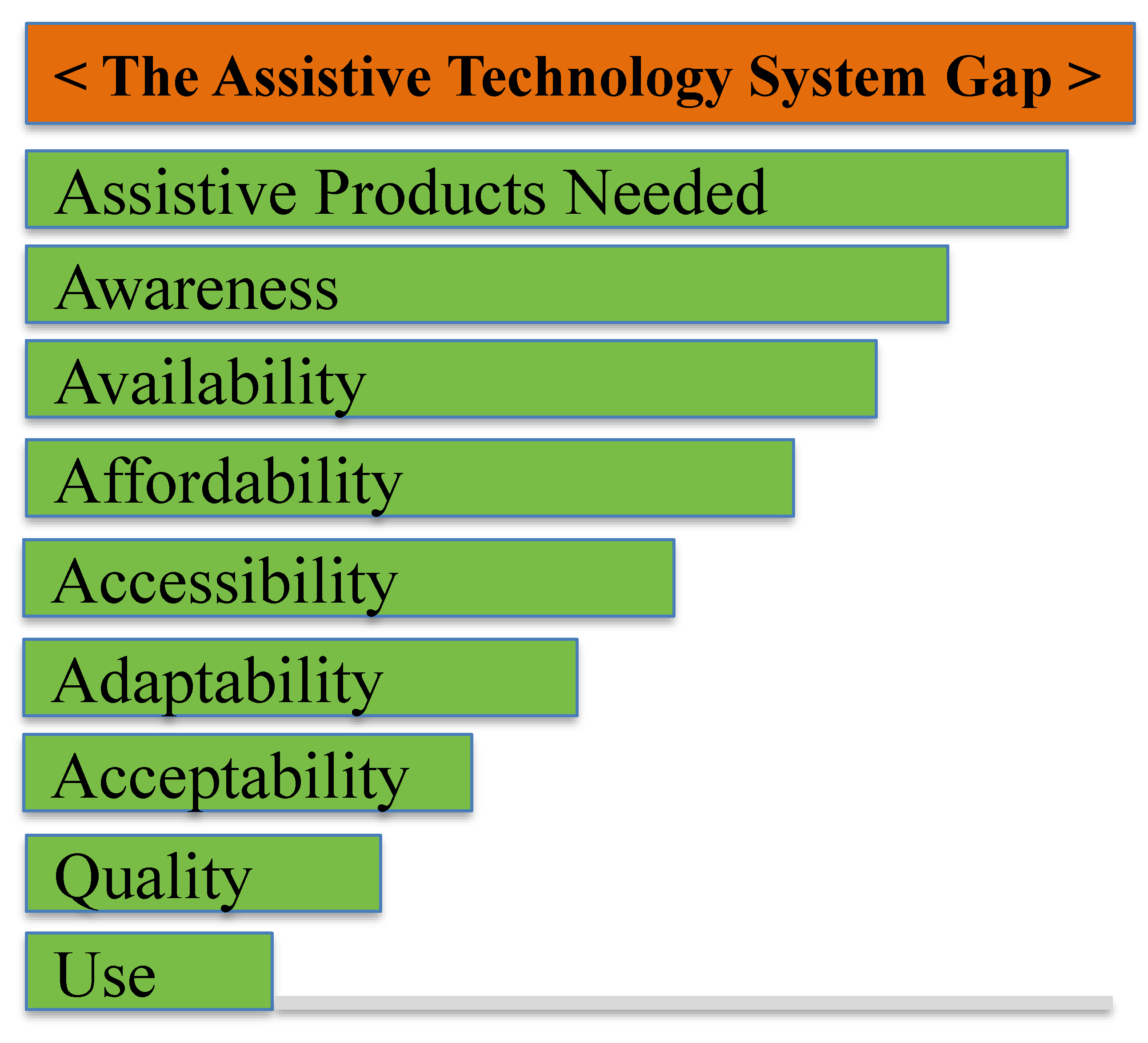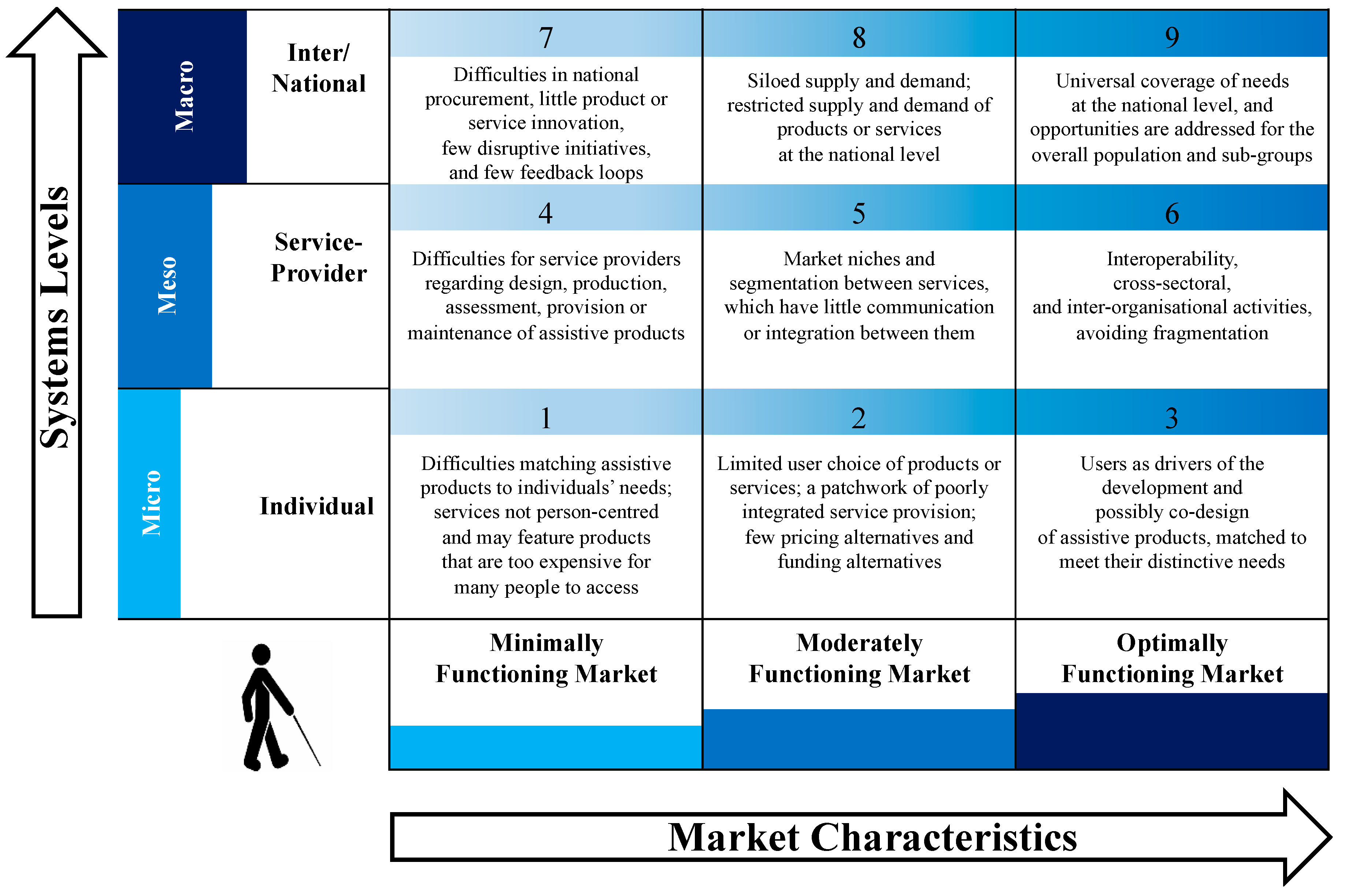Intersections Between Systems Thinking and Market Shaping for Assistive Technology: The SMART (Systems-Market for Assistive and Related Technologies) Thinking Matrix
Abstract
1. Introduction
1.1. Background
1.2. What is Systems Thinking?
1.3. What is Market Shaping?
1.4. What is Assistive Technology?
1.5. Why does Assistive Technology Need Systems Thinking and Market Shaping?
2. Methods
3. Results
4. Discussion
- How to organize to achieve optimal market shaping?
- What regulatory issues may be related to market shaping?
- How might market shaping happen in contexts where procurement-to-scale of AT may be dominated by powerful external stakeholders?
4.1. Organizing Systems Thinking and Market Shaping
4.2. Legal Issues Intersecting Systems Thinking and Market Shaping
4.3. Market Shaping in Contexts Where Procurement-to-Scale of AT May Be Dominated by Powerful External Stakeholders
- Assessment of the need for particular APs.
- Assembly of subcomponents of specific products at the community level.
- Customization of products in terms of aesthetic preferences.
- Fitting of products.
- Support, maintenance and follow-up of products and users.
- Provision of different types of servicing agreements.
- Inclusion of product users through co-design.
- Guarantees on parts and/or servicing.
- Auxiliary services—such as cleaning, decorating, providing an alternative when the usual product is being repaired, or co-location with other services that might be relevant to product users (for instance physiotherapy, employment, or social welfare services).
5. Future Research Recommendations
- What are the barriers and facilitators to adopting a more systemic approach to assistive and related technologies?
- Which government departments should be central to a systemic approach to assistive and related technologies?
- How can systems thinking be used to stimulate innovation in assistive and related technologies?
- What are the barriers and facilitators to moving from minimally to moderately to optimally functioning markets for assistive and related technologies?
- How can strategic alliances be formed between private, public, and voluntary sectors to ensure access to quality and affordable assistive and related technologies, for all?
- How can product or service innovation for assistive and related technologies be most effectively stimulated?
- How can the primacy of the product and service user be incorporated in national-level planning for assistive and related technologies?
- How can key contextual factors (resources, infrastructure, and culture for example) be taken into account to promote the coherence of access to assistive and related technologies, in different countries?
6. Conclusions
Supplementary Materials
Author Contributions
Funding
Acknowledgement
Conflicts of Interest
References
- United Nations General Assembly. Resolution Adopted by the General Assembly on 25 September 2015. Transforming our World: The 2030 Agenda for Sustainable Development; United Nations General Assembly: New York, NY, USA, 2015. [Google Scholar]
- Seventy-First World Health Assembly. Improving Access to Assistive Technology. Available online: http://apps.who.int/gb/ebwha/pdf_files/WHA71/A71_R8-en.pdf?TSPD_101_R0=eaa3b8aaf23929227e06a54f6857f5acl0d0000000000000002bb914e6dffff00000000000000000000000000005bb5df7f00167cf4da (accessed on 12 November 2018).
- Tebbutt, E.; Brodmann, R.; Borg, J.; MacLachlan, M.; Khasnabis, C.; Horvath, R. Assistive products and the Sustainable Development Goals (SDGs). Glob. Health 2016, 12, 1–6. [Google Scholar] [CrossRef] [PubMed]
- World Health Organization (WHO). Assistive Technology; WHO: Geneva, Switzerland, 2018. [Google Scholar]
- Senge, P.M. The Fifth Discipline: The Art & Practice of the Learning Organization, revised ed.; Doubleday: New York, NY, USA, 2006. [Google Scholar]
- Arnold, R.D.; Wade, J.P. A definition of systems thinking: A systems approach. Procedia Comput. Sci. 2015, 44, 669–678. [Google Scholar] [CrossRef]
- MacLachlan, M.; Scherer, M.J. Systems thinking for assistive technology: A commentary on the GREAT summit. Disabil. Rehabil. Assis. Technol. 2018, 13, 492–496. [Google Scholar] [CrossRef] [PubMed]
- Latour, B. Reassembling the Social: An Introduction to Actor-Network-Theory; Oxford University Press: Oxford, UK, 2007. [Google Scholar]
- Latour, B. Aramis, or, the Love of Technology; Harvard University Press: Cambridge, MA, USA, 1996. [Google Scholar]
- Velho, R. Fixing the Gap: An Investigation into Wheelchair Users’ Shaping of London Public Transport. Ph.D. Thesis, University College London, London, UK, 2017. [Google Scholar]
- Richards, E. (Un)Boxing the monster. Soc. Stud. Sci. 1996, 26, 323–356. [Google Scholar] [CrossRef]
- Haraway, D. Simians, Cyborgs, and Women: The Reinvention of Nature; Routledge: New York, NY, USA, 2013. [Google Scholar]
- Bailie, R.; Matthews, V.; Brands, J.; Schierhout, G. A systems-based partnership learning model for strengthening primary healthcare. Implement. Sci. 2013, 8, 1–12. [Google Scholar] [CrossRef] [PubMed]
- De Savigny, D.; Adam, T. (Eds.) Systems Thinking for Health Systems Strengthening; World Health Organization: Geneva, Switzerland, 2009. [Google Scholar]
- Midgley, G. Systems thinking for the 21st century. Int. J. Knowl. Syst. Sci. 2004, 1, 63–69. [Google Scholar]
- Midgley, G. Systems thinking, complexity and the philosophy of science. Émerg. Complex. Organ. 2008, 10, 55–73. [Google Scholar]
- Herlin, H.; Pazirandeh, A. Nonprofit organizations shaping the market of supplies. Int. J. Prod. Econ. 2012, 139, 411–421. [Google Scholar] [CrossRef]
- Clinton, C.; Sridhar, D. Governing Global Health: Who Runs the World and Why? Oxford University Press: New York, NY, USA, 2017. [Google Scholar]
- United States Agency for International Development (USAID). Market Shaping Primer; USAID: Washington, DC, USA, 2014.
- Khasnabis, C.; Mirza, Z.; MacLachlan, M. Opening the GATE to inclusion for people with disabilities. Lancet 2015, 386, 2229–2230. [Google Scholar] [CrossRef]
- International Organization for Standardization (ISO). Assistive Products for Persons with Disability—Classification and Terminology (ISO 9999:2016); ISO: Geneva, Switzerland, 2016. [Google Scholar]
- International Organization for Standardization (ISO). Guide for Addressing Accessibility in Standards (ISO/IEC Guide 71:2014); ISO: Geneva, Switzerland, 2014. [Google Scholar]
- Holloway, C.; Dawes, H. Disrupting the world of disability: The next generation of assistive technologies and rehabilitation practices. Heal. Technol. Lett. 2016, 3, 254–256. [Google Scholar] [CrossRef] [PubMed]
- Velho, R.; Holloway, C.; Symonds, A.; Balmer, B. The effect of transport accessibility on the social inclusion of wheelchair users: A mixed method analysis. Soc. Incl. 2016, 4, 24–35. [Google Scholar] [CrossRef]
- Sen, A. Development as Freedom; Oxford University Press: Oxford, UK, 1999. [Google Scholar]
- Fraser, N. Rethinking recognition. New Left Rev. 2000, 3, 107–120. [Google Scholar]
- World Health Organization (WHO). Global Cooperation on Assistive Technology (GATE). Available online: http://www.who.int/phi/implementation/assistive_technology/en/ (accessed on 12 November 2018).
- World Health Organization (WHO). Global Cooperation on Assistive Technology—About US. Available online: http://www.who.int/phi/implementation/assistive_technology/phi_gate/en/ (accessed on 12 November 2018).
- World Health Organization (WHO). Priority Assistive Products List (APL). Available online: http://www.who.int/phi/implementation/assistive_technology/global_survey-apl/en/ (accessed on 12 November 2018).
- MacLachlan, M.; Banes, D.; Bell, D.; Borg, J.; Donnelly, B.; Fembek, M.; Hooks, H. Assistive technology policy: A position paper from the first global research, innovation, and education on assistive technology (GREAT) summit. Disabil. Rehabil. Assis. Technol. 2018, 13, 454–466. [Google Scholar] [CrossRef] [PubMed]
- MacLachlan, M. China, assistive technology and market shaping re Rise of a new superpower: Health and China’s global trade ambitions. BMJ 2018, 360. [Google Scholar] [CrossRef]
- Arksey, H.; O’Malley, L. Scoping studies: Towards a methodological framework. Int. J. Soc. Res. Methodol. 2005, 8, 19–32. [Google Scholar] [CrossRef]
- Gilson, L. Health Policy and Systems Research: A Methodology Reader; The Abridged Version. Available online: http://www.who.int/alliance-hpsr/resources/alliancehpsr_abridgedversionreaderonline.pdf (accessed on 12 November 2018).
- Cooke, M.; Murphy, E. Moving through crisis and resilience: An activity-centred CONOPs of CI organisations. In Risk, Reliability and Safety: Innovating Theory and Practice, Proceedings of The ESREL 2016, Glasgow, Scotland, 25–29 September 2016; Walls, L., Revie, M., Bedford, T., Eds.; CRC Press: Boca Raton, FL, USA, 2016; pp. 510–517. [Google Scholar]
- Engeström, Y. Learning by Expanding: An Activity-Theoretical Approach to Developmental Research, 2nd ed.; Cambridge University Press: Cambridge, UK, 2015. [Google Scholar]
- Kaptelinin, V.; Nardi, B. Activity theory in HCI: Fundamentals and reflections. Synth. Lect. Hum. Centred Inform. 2012, 5, 1–105. [Google Scholar] [CrossRef]
- IEEE Computer Society. IEEE Guide for Information Technology—System Definition—Concept of Operations (ConOps) Document (IEEE Std 1362–1998); IEEE Computer Society: Washington, DC, USA, 1998. [Google Scholar]
- Mostashari, A.; McComb, S.A.; Kennedy, D.M.; Cloutier, R.; Korfiatis, P. Developing a stakeholder-assisted agile CONOPS development process. Sys. Eng. 2012, 15, 1–13. [Google Scholar] [CrossRef]
- Peters, D.H. The application of systems thinking in health: Why use systems thinking? Health Res. Policy Sys. 2014, 12, 1–6. [Google Scholar] [CrossRef] [PubMed]
- Grudin, J. Why CSCW Applications Fail: Problems in the Design and Evaluation of Organizational Interfaces. In Proceedings of the 1988 ACM Conference on Computer-Supported Cooperative Work, Portland, OR, USA, 26–28 September 1988. [Google Scholar]
- United Nations. Convention on the Rights of Persons with Disabilities and Optional Protocol; United Nations: New York, NY, USA, 2006; Available online: http://www.un.org/disabilities/documents/convention/convoptprot-e.pdf (accessed on 12 November 2018).
- Ferri, D. Does accessible technology need an ‘entrepreneurial state’? The creation of an EU market of universally designed and assistive technology through state aid. Int. Rev. Law Comput. Technol. 2015, 29, 137–161. [Google Scholar] [CrossRef]
- Ferri, D. ‘Subsidising accessibility’: Using EU State Aid law and policy to foster development and production of accessible technology. Eur. State Aid Law Q. 2015, 14, 51–67. [Google Scholar]
- Kline, J.; Ferri, D. Enabling people with disabilities through effective accessible technology policies. In The Changing Disability Policy System: Active Citizenship and Disability in Europe; Halvorsen, R., Hvinden, B., Bickenbach, J., Ferri, D., Guillén Rodriguez, A.M., Eds.; Routledge: New York, NY, USA, 2017; pp. 127–143. [Google Scholar]
- Smith, R.O.; Scherer, M.J.; Cooper, R.; Bell, D.; Hobbs, D.A.; Pettersson, C.; Bauer, S. Assistive technology products: A position paper from the first global research, innovation, and education on assistive technology (GREAT) summit. Disabil. Rehabil. Assis. Technol. 2018, 13, 473–485. [Google Scholar] [CrossRef] [PubMed]
- MacLachlan, M. Access to assistive technology, systems thinking, and market shaping: A response to Durocher et al. N.a. Behav. 2018, 1–5. [Google Scholar] [CrossRef]
- Global Disability Innovation Hub. AT 2030. Available online: https://www.disabilityinnovation.com/at-2030 (accessed on 12 November 2018).


© 2018 by the authors. Licensee MDPI, Basel, Switzerland. This article is an open access article distributed under the terms and conditions of the Creative Commons Attribution (CC BY) license (http://creativecommons.org/licenses/by/4.0/).
Share and Cite
MacLachlan, M.; McVeigh, J.; Cooke, M.; Ferri, D.; Holloway, C.; Austin, V.; Javadi, D. Intersections Between Systems Thinking and Market Shaping for Assistive Technology: The SMART (Systems-Market for Assistive and Related Technologies) Thinking Matrix. Int. J. Environ. Res. Public Health 2018, 15, 2627. https://doi.org/10.3390/ijerph15122627
MacLachlan M, McVeigh J, Cooke M, Ferri D, Holloway C, Austin V, Javadi D. Intersections Between Systems Thinking and Market Shaping for Assistive Technology: The SMART (Systems-Market for Assistive and Related Technologies) Thinking Matrix. International Journal of Environmental Research and Public Health. 2018; 15(12):2627. https://doi.org/10.3390/ijerph15122627
Chicago/Turabian StyleMacLachlan, Malcolm, Joanne McVeigh, Michael Cooke, Delia Ferri, Catherine Holloway, Victoria Austin, and Dena Javadi. 2018. "Intersections Between Systems Thinking and Market Shaping for Assistive Technology: The SMART (Systems-Market for Assistive and Related Technologies) Thinking Matrix" International Journal of Environmental Research and Public Health 15, no. 12: 2627. https://doi.org/10.3390/ijerph15122627
APA StyleMacLachlan, M., McVeigh, J., Cooke, M., Ferri, D., Holloway, C., Austin, V., & Javadi, D. (2018). Intersections Between Systems Thinking and Market Shaping for Assistive Technology: The SMART (Systems-Market for Assistive and Related Technologies) Thinking Matrix. International Journal of Environmental Research and Public Health, 15(12), 2627. https://doi.org/10.3390/ijerph15122627






